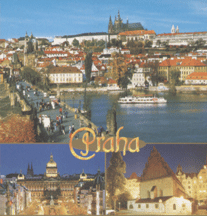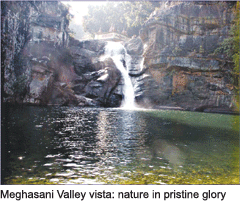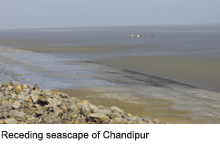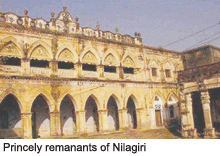Almost three decades ago Kolkata-based poet-author Jayanta Mahapatra was moved by the splendour of “the drunk sea” of Chandipur, and intrigued by an abandoned British cemetery in Balasore, once a major centre of the Indo-Burma trade across the Bay of Bengal, and connected to Calcutta (Kolkata) by boats plying on the river Hoogly
 An unusual tidal phenomenon, a conglomeration of ancient Shiva temples, a defence ministry research base, and historic remnants of India’s freedom struggle make Orissa’s Balasore and Chandipur-on-Sea must-visit tourist destinations in eastern India.
An unusual tidal phenomenon, a conglomeration of ancient Shiva temples, a defence ministry research base, and historic remnants of India’s freedom struggle make Orissa’s Balasore and Chandipur-on-Sea must-visit tourist destinations in eastern India.
Almost three decades ago, Kolkata-based poet-author Jayanta Mahapatra was moved by the splendour of “the drunk sea” of Chandipur, and intrigued by an abandoned British cemetery in Balasore, once a major centre of the Indo-Burma trade across the Bay of Bengal, and connected to Calcutta (Kolkata) by boats plying on the river Hoogly. Through his poetry, Mahapatra highlighted the man versus nature ‘war’ in the state. Since then his observations relating to the fragile ecology and social structure of the region have acquired greater significance in the 21st century.
A coastal riverine town bordered by Midnapore district of West Bengal to the north, the Bay of Bengal to the east and Bhadrak district on the south, Balasore (pop. 106,032) retains its bucolic charm despite its emergence as a (mainly domestic) tourism destination necessary for sustainable development of the local population.
Though the district is still struggling to become a leisure and pilgrim centre (on a par with Puri), it already occupies an important spot on the Indian political map. Neighbouring Chandipur-on-Sea houses the DRDO (Defence Research & Development Organisation), famous for Agni, Nag and Bhramos missile test firings. Entry into this area is restricted.
Numerous mythological tales are linked to the christening of this north Orissa habitation as Balasore. One tale traces its roots to a Persian phrase bale-e-shore which translates into ‘town on the sea’. Another, that it was named after Lord Baneswar (Shiva) and later morphed into ‘Baleswar’.
Today, Balasore and its eponymous district is spread over an area of 3,634 sq. km and divided into three geographical regions — a 81 km coastal strip with ridged sand dunes and brackish water (apt for coconut and betel cultivation, shrimp culture, and salt manufacturing); a fertile deltaic alluvial plain, and the north-western hilly region (Nilagiri sub-division) with a 1,783 ft. peak as its highest point.
Given the size of the district, more than a few days are required to tour Balasore. The main attractions are its beaches, temples, cultural traditions and history. An ideal travel itinerary would be to combine Balasore town with a therapeutic trip to Chandipur-on-sea and other beaches, known for their remarkable tidal phenomena.
Day 1: Balasore
Most travellers visit Balasore for a cultural-cum-historic tour of this ancient, sacred town. However, it’s important to remember this is not a destination for luxury tourists, and its charm at best is rustic. A three-five day stay is sufficient to cover the town and its environs.
 On the itinerary of most visitors are the French and Portuguese ruins (cemeteries and buildings) known as Farasidinga and Dinamardinga; and the temples of Mahadev Baneswar, Jhadeswar and Lakshmi Narayan. Although most of these temple complexes have become inter-mixed with concrete houses and constructions, they retain their age-old stone carvings and wall murals. For the literary-inclined, a homage visit to the shrine (Shanti Kanan) of eminent writer, poet, editor (founder of Utkal Press), critic and administrator Fakir Mohan Senapati, should definitely be on the agenda. Also recommended is a visit to Khulia, a scenic settlement of aboriginal people about 33 km from Balasore.
On the itinerary of most visitors are the French and Portuguese ruins (cemeteries and buildings) known as Farasidinga and Dinamardinga; and the temples of Mahadev Baneswar, Jhadeswar and Lakshmi Narayan. Although most of these temple complexes have become inter-mixed with concrete houses and constructions, they retain their age-old stone carvings and wall murals. For the literary-inclined, a homage visit to the shrine (Shanti Kanan) of eminent writer, poet, editor (founder of Utkal Press), critic and administrator Fakir Mohan Senapati, should definitely be on the agenda. Also recommended is a visit to Khulia, a scenic settlement of aboriginal people about 33 km from Balasore.
Historically this region was a component of the ancient Kalinga kingdom. In 1568 the Moguls annexed it and ruled until 1750. Post 1751, the writ of Marahata Rajas of Nagpur ran here until the early 19th century, when the East India Company officially took it over and declared it a district of the Bengal Presidency (1828).
Chasakhand. A mere 5 km from Balasore (a 15-minute drive on the NH 5), Chasakhand is known for its memorial to revolutionary ‘Bagha’ (Tiger) Jatin Mukherjee, a young rebel who with his friends took on the might of the British empire. Tourists undertake this rakhta tirtha (‘blood pilgrimage’) to pay respects to these largely unsung freedom fighters.
Remuna. About 9 km from Balasore, Remuna hosts the multi-coloured Khirochora Gopinath temple built by King Langula Narasimha Dev (who also built the Sun Temple at Konark, 30 km from Puri). This area has been a bastion of Hindu Vaishn-avism for centuries, and it’s believed that Madhavendra Puri, Guru of Sri Chaitanya Mahaprabhu worshiped the Lord at Remuna. The simple ritual of specially prepared milk doled out as prasad, is the highpoint for the faithful.
Other temples and sites in the vicinity are Biranchi Narayana, Asta Durga, Ayodhya (mythological remains have been unearthed at this site) and Bhudhar Chandi. Stone carvings adorn the walls of these temples, situated within the Nilagiri Raj military base of Sajanagarh.
Day 2: Deokund
This scenic leisure and picnic spot in the Meghasani Valley, 95 km from Balasore, offers breathtaking vistas of silver waterfalls slicing the green hills of the valley. This is nature in pristine glory, and all one can do here is to behold and revel in it.
Accommodation at Balasore. A range of hotels are available to suit all budgets. Mid-range: Torrento Hotel (Rs.1,200 per night onwards); the Orissa Tourism Development Corporation’s Panthanivas (Rs.1,000 plus). Budget: Anadamayee Hotel (Rs.600 onwards), Luxury Inn (Rs.300). Moreover there are several small hotels which offer rooms priced between Rs.50-Rs.1,000 per night.
Local transport. The public transport available is less than rudimentary. Therefore the best option is to get around in taxis which charge Rs.900-1,200 for the excursions outlined above. Local buses and metred autorickshaws ply within municipal limits.
Shopping. Orissa ikat saris, lacquered toys of Balasore and brass artifacts of Remuna are favourite purchases of visitors.
Getting there
By Air. The airports nearest to Balasore are Bhubaneswar and Kolkata. From both, Balasore is a five-hour drive depending on road conditions.
By Rail. The nearest rail heads are Bhubaneswar, Kolkata and Puri. Trains run at regular intervals.
By Road. Balasore is 220 km from Kolkata and 215 km from Bhubaneswar (Kolkata-Chennai national highways pass through the district. NH 5 covers a distance of about 66 km and NH 60 covers a distance of 53 km). Private vehicles and bus services are available.
Day 3: Chandipur-on-Sea
 From Balasore town, Chandipur is a bumpy 30-minute ride (16 km) along the Grand Trunk Road built by King Sukumar Sen in 1827 for pilgrims from Bengal. Chandipur is legendary for its amazing low tides, when the sea recedes 3-5 km from the shore every morning, exposing a flat continental shelf. Instead of the usual hurtling waves, a placid stretch of unending land greets the visitor. Sunrise is the best time to enjoy the view when a carroty globe peeps from behind the clouds and casts a warm glow on the wet and spongy beach. A walk on the sand soothes aching feet, while birdsong fills the air.
From Balasore town, Chandipur is a bumpy 30-minute ride (16 km) along the Grand Trunk Road built by King Sukumar Sen in 1827 for pilgrims from Bengal. Chandipur is legendary for its amazing low tides, when the sea recedes 3-5 km from the shore every morning, exposing a flat continental shelf. Instead of the usual hurtling waves, a placid stretch of unending land greets the visitor. Sunrise is the best time to enjoy the view when a carroty globe peeps from behind the clouds and casts a warm glow on the wet and spongy beach. A walk on the sand soothes aching feet, while birdsong fills the air.
Most hotel complexes resemble composite villages by the sea. Among the more notable is Hotel Santi Niwas, proclaimed by a dilapidated and dusty board, but offering a splendid hand-painted reception hut. This property, featuring a 25-year-old Shiva temple, is sited within a spectacular grove of coconut, mango, casurina, eucalyptus and keya trees. Huts are connected by brick pathways on which geese, hens, dogs and parrots are ubiquitous. The hotel offers concrete residential structures and thatched huts. Large, globular glass lamps hang precariously from wooden beams. A common veranda encircles the rooms.
The hotel complexes of Chandipur are perfect for languid afternoons and beach baths. The tide rises around 5 pm and keeps rising until midnight. Evenings and nights are tranquil, with light sea breezes accompanying the roar of waves. Most beach hotels arrange for firewood (Rs.5-10 per kg) for beach parties, where nature lovers can enjoy the company of eerie bats, brown-white barn owls and chubby beetles.
Day 4: Panchalingeshwar Temple
.gif) Balasore’s history allowed Hinduism, Buddhism, Jainism (popular in 10th and 11th centuries), Islam, Christianity and even Sikhism (gurudwara at Remuna) to flourish in north-east Orissa. However, the main tourist attractions of the district are the Shiva temples of Panchalingeshwar, Chandaneshwar, Baneswar, Jhadeshwar, Bhusandeshwar and Maninageshwar. Especially notable among them is the 600-year-old Panchalingeshwar temple, 45 km from Chandipur. Set in a dense forest atop a rocky outcrop of the Nilagiri hills, visitors must climb 600 steps to reach the summit and pay obeisance to its five lingams washed by a perennial stream. Devotees tie bunches of red bangles and thread on the prop roots of an old banyan tree, praying for wish fulfillment.
Balasore’s history allowed Hinduism, Buddhism, Jainism (popular in 10th and 11th centuries), Islam, Christianity and even Sikhism (gurudwara at Remuna) to flourish in north-east Orissa. However, the main tourist attractions of the district are the Shiva temples of Panchalingeshwar, Chandaneshwar, Baneswar, Jhadeshwar, Bhusandeshwar and Maninageshwar. Especially notable among them is the 600-year-old Panchalingeshwar temple, 45 km from Chandipur. Set in a dense forest atop a rocky outcrop of the Nilagiri hills, visitors must climb 600 steps to reach the summit and pay obeisance to its five lingams washed by a perennial stream. Devotees tie bunches of red bangles and thread on the prop roots of an old banyan tree, praying for wish fulfillment.
Balaramgadi. Sited 3 km from Chandipur on the banks of the river Budhibalang, this is one of Chandipur’s main fishing harbours. Tourists can watch fishing trawlers and boats laden with hilsa, pomfret and prawns. The catch is stored in an in-built cold storage unit on the trawler. Ice is fed into rusty ice crushers on the jetty, that gobble chunks of ice physically thrown in by young men. In seconds, crushed ice fills a vat embedded in the trawler’s hull.
 Nilagiri. This is one of the sub-divisions of Balasore district, in the foothills of the Eastern Ghats and is famous for its Jagannath temple at Rajbati (40 km from Chandipur). Also on view are the dilapidated ruins of the princely state of Nilagiri.
Nilagiri. This is one of the sub-divisions of Balasore district, in the foothills of the Eastern Ghats and is famous for its Jagannath temple at Rajbati (40 km from Chandipur). Also on view are the dilapidated ruins of the princely state of Nilagiri.
Day 5: Beaches
Chandipur is a good base for visiting the beaches of Kashaphal, Chawmukh and Dagara, and Kharasahapur. Most of them are ringed by casurina and eucalyptus trees, and are a beach-comber’s delight, strewn with sea shells and driftwood. Fishing excursions with locals is de rigueur with the price thereof determined by the whims and fancies of country boatmen.
The pick of the beaches is Kashaphal (36 km from Balasore), a small fishing harbour near Basta village lined with whistling casurina trees. Other hamlets with inviting beaches are Chawmukh and Dagara (replete with red crabs), and Kharasahapur, a sandy beach about 37 km south-east of Balasore, featuring a Mangala temple and a jetty that allows boating.
Accommodation at Chandipur-on-Sea. It’s best to book accommodation on the internet or take a chance on arrival. Tariffs range from Rs.50 onwards per bed to Rs.700 per night or more for an air-conditioned room. Other options are OTDC’s Panthanivas (Rs.700), Santi Nivas (six-bedrooms in a thatched hut for Rs.600), Hotel Shubham, Hotel Chandipur, Pacific Holiday Inn, Sand n’ Sea and others.
Shopping. Street shops are stocked with bric-a-brac, textiles and handicrafts. Especially popular are shell and pearl jewellery, wooden artifacts, hand-made baskets and beautiful stone carvings.
Getting there. Chandipur-on-Sea is a mere 16 km by road from Balasore. Besides private taxis (Rs.500 onwards), buses, auto-rickshaws (Rs.120-150) and public taxis (Rs.200) are the other modes of transport for reaching there.
|
Travel advisory
• Average winter temperatures in Balasore fluctuate between 22-32o C.
• The best time to visit Balasore/Chandipur-on-Sea is November-February after which temperatures can shoot up to 40o C.
• Even in winter, sun and heat protection gear is essential. Light cotton clothes, sunscreen, sunglasses, hat, cap or scarf recommended.
• Carry special medicines (if any) and basic travel essentials.
• One could pack a tent and sleeping bag (if adventure is on the cards). However, only group camping is advisable.
• Learning a few words of Oriya helps while communicating with the locals.
• It’s advisable to opt for local cuisine (Rs.25 or more for a vegetarian thali). Stick to packaged drinking water.
|
Bhavana Pingali Datta